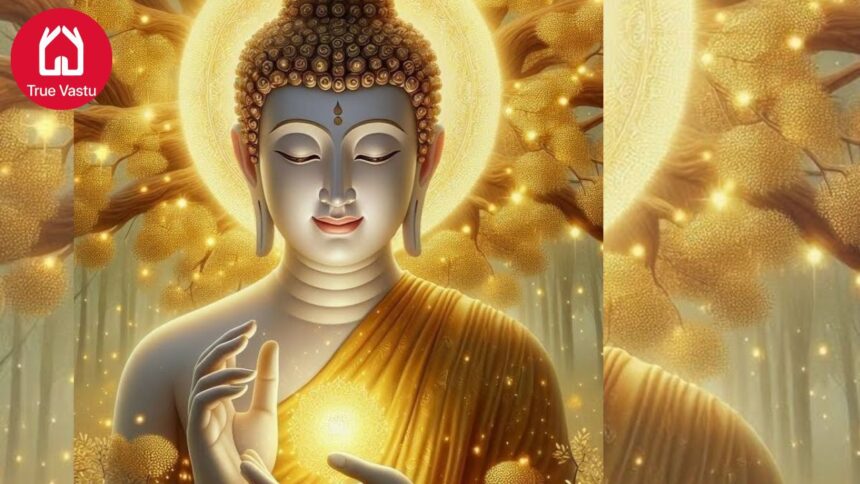Buddha statues are not just beautiful pieces of art, but they are also powerful symbols of peace, wisdom, and positivity. For centuries, followers of Buddhism and spiritual seekers have worshipped Buddha statues as a source of reverence and inspiration. Nowadays, Buddha statues have also become popular as decorative items in homes, offices, and gardens. However, did you know that there are some important Vastu principles that need to be followed when placing a Buddha statue at home? If the Buddha statue is installed according to the right Vastu rules, it can bring peace, prosperity, and positive energy to the house. On the contrary, placing it in the wrong direction or location can have negative effects. In this blog post, we will discuss in detail the true Vastu principles associated with the Buddha statue and know which Buddha statue is best suited for your home.
Importance of Buddha Statues
Buddha statues represent the teachings of Lord Buddha and his calm nature. The posture (asana) and hand gesture (mudra) of each statue symbolize a particular meaning and energy. For example, a Buddha statue seated in a dhyan mudra symbolises peace of mind and concentration, while abhaya mudra (hands raised up) symbolises dispelling fear and negativity. Placing a Buddha statue at home creates a calm and spiritual environment, which reduces stress and brings positive thoughts. It reminds us of the teachings of Lord Buddha and inspires us to live a more compassionate and conscious life.
True Vastu Principles for Buddha Statue
Vastu Shastra is an ancient Indian science based on the balance of directions and energy. When it comes to placing a Buddha statue at home, it is extremely important to follow the rules of Vastu so as to reap maximum positive benefits. Here are some key Vastu principles that you should keep in mind:
Choosing the right direction
Choosing the right direction to place a Buddha statue is of utmost importance. According to Vastu Shastra, the Buddha statue should always be placed facing the east direction. The east direction is considered the direction of sunrise and symbolises positive energy and new beginnings. If the east direction is not possible, you can also choose the north-east direction (Ishaan Kon) or the north direction. The north-east direction is considered to be the place of the gods and is extremely auspicious for knowledge, spirituality and peace. The north direction is associated with wealth and prosperity.
Never place the Buddha statue facing the south direction, as this direction is considered to be related to negative energy and death. Similarly, one should also avoid placing it facing the west direction, as this direction signifies stability and stagnation, which can be the opposite of the dynamic energy of the Buddha.
Choosing the right location
Along with the direction, choosing the right location for the Buddha statue is also important. The statue should always be placed in a clean and quiet place, where there is adequate light. You can install it in the living room, meditation room or puja room. Make sure not to place the statue directly on the floor; always place it on an elevated place, such as a table or pedestal.
There are some places where Buddha statue should never be placed:
Bedroom: According to Vastu Shastra, it is not considered appropriate to keep Buddha statue in the bedroom, as this place is relaxing and private, whereas Buddha statue is a symbol of purity and reverence. If you want to keep it in the bedroom, do not keep it facing your feet.
Bathroom and toilet: These places are considered impure, so it is extremely inauspicious to keep Buddha statue here.
Kitchen: The kitchen is dominated by the fire element, which can be contrary to the calm energy of Buddha.
Under the stairs: The place under the stairs is considered a center of negative energy, so Buddha statue should not be kept here.
Right in front of the door: Avoid placing Buddha statue right in front of the main door, as it can obstruct the flow of energy.
Keep the height in mind
Buddha statue should always be kept at or above your eye level. This means that when you stand in front of the statue, your sight should naturally fall on it. A statue looking downwards is not considered respectful.
Cleanliness and Respect
Always keep the Buddha statue clean. Clean the dust regularly and ensure that the surrounding area is orderly and calm. Always show respect to the statue. Never behave rudely in front of it or bring negative thoughts.
Different Buddha Mudras and Vastu
Buddha statues come in various mudras and hand gestures, each of which has its own specific meaning and Vastu significance. Some of the popular Buddha mudras and their Vastu effects are as follows:
Dhyana Mudra: In this mudra, Buddha keeps both hands in the lap, palms facing upwards and thumbs touching each other. This mudra signifies deep concentration, peace and meditation. Keeping a statue in this mudra at home calms the mind and helps in spiritual growth. It is best to keep it in the puja room or any quiet place.
Abhaya Mudra: In this mudra, one of Buddha’s hands is raised upwards, palm facing outwards and fingers straight. This mudra symbolizes the removal of fear, dread and negativity. Placing a statue of this mudra near the main entrance of the house or in the living room brings protection and positive energy.
Bhumisparsha Mudra: In this mudra, Buddha’s right hand is downwards touching the earth, while the left hand is in the lap. This mudra represents the moment of Buddha’s enlightenment, when he made the earth a witness to his truth. The statue of this mudra symbolizes stability, determination and victory of truth in the house. It is considered auspicious to keep it in the east direction.
Varada Mudra: In this mudra, one of Buddha’s hands is extended downwards, palm facing outwards and fingers pointing downwards. This mudra symbolizes charity, compassion and blessing. The statue of this mudra brings happiness, prosperity and positivity in the house. It is suitable to place it in the north direction.
Walking Buddha: In this posture, Buddha is shown walking. It symbolizes the journey of progress, mobility and inner peace. Keeping this statue in the house inspires to move forward in life and removes obstacles. It is considered good to place it in the north-east or east direction.
Reclining Buddha: This posture represents the Mahaparinirvana (death) of Buddha, but it also symbolizes peace and detachment. The statue of this posture should be placed carefully in the house and it should not be placed in the bedroom facing the feet. It is advisable to place it in a quiet and respectful place.
Laughing Buddha: Although technically it is not a statue of Lord Buddha, but represents the Buddha of the future, Bodhisatva Maitreya, the Laughing Buddha is considered a symbol of good luck, prosperity and happiness. In Vastu Shastra, it is advisable to place it facing the main entrance of the house so that positive energy can come in.
Things to keep in mind while placing a Buddha statue
Old or broken statues: Never place an old, broken or damaged Buddha statue in the house. Such statues can bring negative energy. If you have any such statue, immerse it respectfully in a sacred place.
More than one statue: It can be auspicious to have more than one Buddha statue in the house, but make sure they are in different places and not crowded near each other.
With other idols: If you are placing the Buddha statue along with idols of other deities, make sure the Buddha statue always gets a higher place.
Choice of material: Buddha statues are made of different materials such as wood, metal, stone and clay. You can choose any material according to your choice and Vastu requirements.
Choice of size: The size of the statue should be according to the size of your house and the place where you want to install it. Too big or too small statues can create imbalance.
Benefits of installing Buddha statue in the right place
If the Buddha statue is installed in the house according to the right Vastu principles, it can have many positive benefits:
Peace and harmony: The Buddha statue creates an atmosphere of peace and harmony in the house, which increases love and harmony among the family members.
Positive energy: It removes negative energy and increases the flow of positive energy, which brings happiness in the house.
Mental peace and concentration: The Buddha statue in Dhyana Mudra helps in calming the mind and increasing concentration, which is perfect for meditation and spiritual practice.
Protection and fearlessness: The Buddha statue in Abhaya Mudra protects the house from evil eyes and negative forces and creates a sense of fearlessness in the mind.
Prosperity and good luck: Varada Mudra and Laughing Buddha statues bring wealth, prosperity and good luck to the house.
Spiritual growth: The Buddha statue reminds us of the teachings of Lord Buddha and inspires us to follow the religious and spiritual path.
Buddha statues not only enhance the beauty of your home, but it can also become a source of positive energy and spiritual peace. However, it is important that you install the Buddha statue according to the right rules of Vastu Shastra so that you can get maximum benefits from it. By choosing the right direction, right place and right posture, you can bring happiness, peace and prosperity to your home. Always treat the Buddha statue with respect and keep it in a clean and sacred place. By following these simple Vastu principles, you can create a positive and harmonious environment in your home.
FAQs about Buddha Statue and Vastu
What is the right place to keep a Buddha statue in the house?
It is considered auspicious to keep a Buddha statue in the east direction or in front of the main door. It increases positive energy and prevents negative effects. Keeping a Buddha statue in a meditative pose in the drawing room maintains peace.
Is it right to keep a Buddha statue in the bedroom?
No, according to Vastu Shastra, it is not considered appropriate to keep a Buddha statue in the bedroom. It can have the opposite effect of peace and positive energy. It is more auspicious to keep it in the drawing room, garden or place of worship.
Where should the Laughing Buddha be kept?
It is auspicious to keep the Laughing Buddha in the house or office near the main door facing inwards. It brings wealth, prosperity and good luck. Do not keep it on the floor, but install it on a table or high place.
Can Buddha statue be kept in the office?
Yes, keeping a Buddha statue in the office maintains peace and concentration in the workspace. It is considered good to keep it near the main entrance, reception, or work desk. It increases mental peace as well as success and prosperity.









